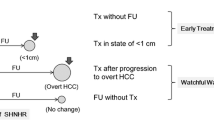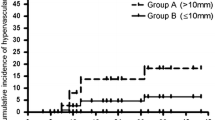Abstract
Background
Hypovascular tumors associated with hepatocellular carcinoma (HCC) can be diagnosed, but it remains unknown whether such lesions should be treated immediately. This study aimed to clarify the clinical significance of treating hypovascular liver nodules.
Methods
After diagnosis of hypovascular tumors smaller than 3 cm, 104 patients underwent liver resection immediately (Group 1), while 93 patients were placed under observation (Group 2). In Group 1, 98 patients were diagnosed as having HCC (Group 1′), while 80 patients in Group 2 underwent liver resection after vascularization or appearance of other hypervascular HCC (Group 2′), eight patients had been observed, and five patients could not undergo operation due to appearance of other multiple HCCs. To avoid lead time bias for tumor vascularization, survival rates of patients after diagnosis of hypovascular tumors as well as those after operation in the two groups were compared.
Results
After a median follow-up of 3.3 years (range 0.6–11.2), the 5-year overall survival rates after liver resection of Group 1′ (74.8 %; 95 % CI 64.3–86.1) was significantly higher than that of Group 2′ (59.2 %; 46.4–75.6; P = 0.027). However, the 5-year overall survival rates after diagnosis of hypovascular liver nodules of Group 1′ (74.7 %; 66.1–85.0) was not significantly different from that of Group 2′ (77.1 %; 67.0–88.6; P = 0.761). Consequently, the 5-year overall survival rate after diagnosis of Group 2 (75.6 %; 64.7–83.1) was not significantly different from that of Group 1 (73.2 %; 67.5–86.1; P = 0.591) by intention-to-treat analysis.
Conclusions
It is not necessary to treat hypovascular liver tumors immediately after diagnosis.



Similar content being viewed by others
References
Forner A, Llovet JM, Bruix J (2012) Hepatocellular carcinoma. Lancet 379:1245–1255
Bruix J, Sherman M (2011) Management of hepatocellular carcinoma: an update. Hepatology 53:1020–1022
Takayama T, Makuuchi M, Kojiro M et al (2008) Early hepatocellular carcinoma: pathology, imaging, and therapy. Ann Surg Oncol 15:972–978
Akai H, Matsuda I, Kiryu S et al (2012) Fate of hypointense lesions on Gd-EOB-DTPA-enhanced magnetic resonance imaging. Eur J Radiol 81:2973–2977
Kumada T, Toyoda H, Tada T et al (2011) Evolution of hypointense hepatocellular nodules observed only in the hepatobiliary phase of gadoxetate disodium-enhanced MRI. AJR Am J Roentgenol 197:58–63
Midorikawa Y, Takayama T, Shimada K et al (2013) Marginal survival benefit in the treatment of early hepatocellular carcinoma. J Hepatol 58:306–311
Roncalli M, Borzio M, Di Tommaso L (2008) Hepatocellular dysplastic nodules. Ann Ital Chir 79:81–89
Takayama T, Makuuchi M, Hirohashi S et al (1998) Early hepatocellular carcinoma as an entity with a high rate of surgical cure. Hepatology 28:1241–1246
Yamamoto M, Takasaki K, Otsubo T et al (2004) Favorable surgical outcomes in patients with early hepatocellular carcinoma. Ann Surg 239:395–399
Forner A, Vilana R, Ayuso C et al (2008) Diagnosis of hepatic nodules 20 mm or smaller in cirrhosis: prospective validation of the noninvasive diagnostic criteria for hepatocellular carcinoma. Hepatology 47:97–104
International Consensus Group for Hepatocellular Neoplasia (2009) Pathologic diagnosis of early hepatocellular carcinoma: a report of the international consensus group for hepatocellular neoplasia. Hepatology 49:658–664
Toyoda H, Kumada T, Tada T et al (2013) Non-hypervascular hypointense nodules detected by Gd-EOB-DTPA-enhanced MRI are a risk factor for recurrence of HCC after hepatectomy. J Hepatol 58:1174–1180
Takayama T, Makuuchi M, Hirohashi S et al (1990) Malignant transformation of adenomatous hyperplasia to hepatocellular carcinoma. Lancet 336:1150–1153
Takayama Y, Nishie A, Nakayama T et al (2012) Hypovascular hepatic nodule showing hypointensity in the hepatobiliary phase of gadoxetic acid-enhanced MRI in patients with chronic liver disease: prediction of malignant transformation. Eur J Radiol 81:3072–3078
Takayasu K, Arii S, Sakamoto M et al (2013) Clinical implication of hypovascular hepatocellular carcinoma studied in 4,474 patients with solitary tumour equal or less than 3 cm. Liver Int 33:762–770
Bolondi L, Gaiani S, Celli N et al (2005) Characterization of small nodules in cirrhosis by assessment of vascularity: the problem of hypovascular hepatocellular carcinoma. Hepatology 42:27–34
Hayashi M, Matsui O, Ueda K et al (1999) Correlation between the blood supply and grade of malignancy of hepatocellular nodules associated with liver cirrhosis: evaluation by CT during intraarterial injection of contrast medium. AJR Am J Roentgenol 172:969–976
Cho YK, Wook Chung J, Kim Y et al (2011) Radiofrequency ablation of high-grade dysplastic nodules. Hepatology 54:2005–2011
Mourad A, Deuffic-Burban S, Ganne-Carrie N et al (2014) Hepatocellular carcinoma screening in patients with compensated hepatitis C virus (HCV)-related cirrhosis aware of their HCV status improves survival: a modeling approach. Hepatology 59:1471–1481
Matsui O, Gabata T, Kobayashi S et al (2007) Imaging of multistep human hepatocarcinogenesis. Hepatol Res 37(Suppl 2):S200–S205
Barratt A, Mannes P, Irwig L et al (2002) Cancer screening. J Epidemiol Community Health 56:899–902
Gotzsche PC, Olsen O (2000) Is screening for breast cancer with mammography justifiable? Lancet 355:129–134
Kaji K, Terada T, Nakanuma Y (1994) Frequent occurrence of hepatocellular carcinoma in cirrhotic livers after surgical resection of atypical adenomatous hyperplasia (borderline hepatocellular lesion): a follow-up study. Am J Gastroenterol 89:903–908
Acknowledgment
This work was mainly supported by a Grant-in-Aid for Scientific Research (C) 15K10152 (Y.M.) from the Ministry of Education, Culture, Sports, Science and Technology (MEXT), Japan.
Author information
Authors and Affiliations
Corresponding author
Ethics declarations
Conflict of interest
We declare that we have no conflicts of interest.
Additional information
Trial registration number
This work is not a randomized clinical trial.
Rights and permissions
About this article
Cite this article
Midorikawa, Y., Takayama, T., Nara, S. et al. No Need of Immediate Treatment for Hypovascular Tumors Associated with Hepatocellular Carcinoma. World J Surg 40, 2460–2465 (2016). https://doi.org/10.1007/s00268-016-3548-4
Published:
Issue Date:
DOI: https://doi.org/10.1007/s00268-016-3548-4




